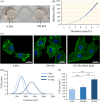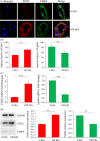Matrix stiffness regulates arteriovenous differentiation of endothelial progenitor cells during vasculogenesis in nude mice
- PMID: 30485569
- PMCID: PMC6495479
- DOI: 10.1111/cpr.12557
Matrix stiffness regulates arteriovenous differentiation of endothelial progenitor cells during vasculogenesis in nude mice
Abstract
Objectives: The aim of the study was to investigate the effect of matrix stiffness on arteriovenous differentiation of endothelial progenitor cells (EPCs) during vasculogenesis in nude mice.
Materials and methods: Dextran hydrogels of differing stiffnesses were first prepared by controlling the crosslinking reaction to generate different thioether bonds. Hydrogels with stiffnesses matching those of the arterial extracellular matrix and venous extracellular matrix were separately combined with mouse bone marrow-derived EPCs and subcutaneously implanted on either side of the backs of nude mice. After 14 days, artery-specific marker Efnb2 and vein-specific marker Ephb4 in the neovasculature were detected to determine the effect of matrix stiffness on the arteriovenous differentiation of EPCs in vivo.
Results: Fourteen days after the implantation of the EPC-loaded dextran hydrogels, new blood vessels were observed in both types of hydrogels. We further verified that matrix stiffness regulated the arteriovenous differentiation of EPCs during vasculogenesis via the Ras/Mek pathway.
Conclusions: Matrix stiffness regulates the arteriovenous differentiation of EPCs during vasculogenesis in nude mice through the Ras/Mek pathway.
Keywords: Ras/Mek pathway; arteriovenous development; matrix characteristics; tissue engineering; vasculogenesis.
© 2018 The Authors. Cell Proliferation Published by John Wiley & Sons Ltd.
Conflict of interest statement
The authors declare that they have no competing interests.
Figures






Similar articles
-
Endothelial progenitor cells for fabrication of engineered vascular units and angiogenesis induction.Cell Prolif. 2024 Sep;57(9):e13716. doi: 10.1111/cpr.13716. Epub 2024 Jul 25. Cell Prolif. 2024. PMID: 39051852 Free PMC article. Review.
-
Matrix stiffness regulates neovascular homeostasis through autophagy in nude mice.J Cell Physiol. 2023 Sep;238(9):2135-2146. doi: 10.1002/jcp.31074. Epub 2023 Aug 10. J Cell Physiol. 2023. PMID: 37565586
-
Substrate stiffness regulates arterial-venous differentiation of endothelial progenitor cells via the Ras/Mek pathway.Biochim Biophys Acta Mol Cell Res. 2017 Oct;1864(10):1799-1808. doi: 10.1016/j.bbamcr.2017.07.006. Epub 2017 Jul 18. Biochim Biophys Acta Mol Cell Res. 2017. PMID: 28732675
-
Comparison between endothelial progenitor cells and human umbilical vein endothelial cells on neovascularization in an adipogenesis mouse model.Microvasc Res. 2015 Jan;97:159-66. doi: 10.1016/j.mvr.2014.10.005. Epub 2014 Oct 27. Microvasc Res. 2015. PMID: 25446371
-
Endothelial Progenitor Cells for the Vascularization of Engineered Tissues.Tissue Eng Part B Rev. 2018 Feb;24(1):1-24. doi: 10.1089/ten.TEB.2017.0127. Epub 2017 Jul 3. Tissue Eng Part B Rev. 2018. PMID: 28548628 Free PMC article. Review.
Cited by
-
Single-Cell Transcriptomics Reveals Zone-Specific Alterations of Liver Sinusoidal Endothelial Cells in Cirrhosis.Cell Mol Gastroenterol Hepatol. 2021;11(4):1139-1161. doi: 10.1016/j.jcmgh.2020.12.007. Epub 2020 Dec 16. Cell Mol Gastroenterol Hepatol. 2021. PMID: 33340713 Free PMC article.
-
Injectable nanoporous microgels generate vascularized constructs and support bone regeneration in critical-sized defects.Sci Rep. 2022 Sep 22;12(1):15811. doi: 10.1038/s41598-022-19968-x. Sci Rep. 2022. PMID: 36138042 Free PMC article.
-
Endothelial progenitor cells for fabrication of engineered vascular units and angiogenesis induction.Cell Prolif. 2024 Sep;57(9):e13716. doi: 10.1111/cpr.13716. Epub 2024 Jul 25. Cell Prolif. 2024. PMID: 39051852 Free PMC article. Review.
-
Mechanosensitive Ion Channel Piezo1 Activated by Matrix Stiffness Regulates Oxidative Stress-Induced Senescence and Apoptosis in Human Intervertebral Disc Degeneration.Oxid Med Cell Longev. 2021 Feb 10;2021:8884922. doi: 10.1155/2021/8884922. eCollection 2021. Oxid Med Cell Longev. 2021. PMID: 33628392 Free PMC article.
-
Dynamic Stimulations with Bioengineered Extracellular Matrix-Mimicking Hydrogels for Mechano Cell Reprogramming and Therapy.Adv Sci (Weinh). 2023 Jul;10(21):e2300670. doi: 10.1002/advs.202300670. Epub 2023 Apr 29. Adv Sci (Weinh). 2023. PMID: 37119518 Free PMC article. Review.
References
-
- Augustin HG, Koh GY. Organotypic vasculature: from descriptive heterogeneity to functional pathophysiology. Science. 2017;357(6353):eaal2379. - PubMed
-
- Bompais H, Chagraoui J, Canron X, et al. Human endothelial cells derived from circulating progenitors display specific functional properties compared with mature vessel wall endothelial cells. Blood. 2004;103(7):2577. - PubMed
-
- Asahara T, Masuda H, Takahashi T, et al. Bone marrow origin of endothelial progenitor cells responsible for postnatal vasculogenesis in physiological and pathological neovascularization. Circ Res. 1999;85(3):221‐228. - PubMed
-
- Hur J, Yoon CH, Kim HS, et al. Characterization of two types of endothelial progenitor cells and their different contributions to neovasculogenesis. Arterioscler Thromb Vasc Biol. 2004;24(2):288‐293. - PubMed
-
- Obi S, Yamamoto K, Shimizu N, et al. Fluid shear stress induces arterial differentiation of endothelial progenitor cells. J Appl Physiol. 2009;106(1):203‐211. - PubMed
MeSH terms
Substances
Grants and funding
LinkOut - more resources
Full Text Sources
Research Materials
Miscellaneous

